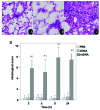Mitochondrial DNA induces inflammation and increases TLR9/NF-κB expression in lung tissue
- PMID: 24535292
- PMCID: PMC3976143
- DOI: 10.3892/ijmm.2014.1650
Mitochondrial DNA induces inflammation and increases TLR9/NF-κB expression in lung tissue
Retraction in
-
[Retracted] Mitochondrial DNA induces inflammation and increases TLR9/NF‑κB expression in lung tissue.Int J Mol Med. 2023 Mar;51(3):28. doi: 10.3892/ijmm.2023.5231. Epub 2023 Feb 17. Int J Mol Med. 2023. PMID: 36799160 Free PMC article.
Abstract
Mitochondrial DNA (mtDNA) contains unmethylated CpG motifs that exhibit immune stimulatory capacities. The aim of this study was to investigate whether mtDNA activates the Toll-like receptor 9 (TLR9)/nuclear factor-κB (NF-κB) pathway, thereby contributing to post-traumatic systemic inflammatory response syndrome (SIRS) and lung injury in rats. The effects of mtDNA on macrophage culture were examined in order to elucidate the putative cellular mechanisms. Rats and macrophage cultures were treated with phosphate-buffered saline, nuclear DNA, or mtDNA for 2, 4, 8 and 24 h. Histological analysis of lung tissue was undertaken following hematoxylin and eosin staining, and cytokine levels were assessed by ELISA. NF-κB and IκB-α phosphorylation levels, as well as TLR9 protein expression were determined by western blot analysis; NF-κB, IκB-α and TLR9 mRNA levels were analyzed by RT-PCR. A greater degree of inflammation and lung injury was observed in response to mtDNA. In addition, mtDNA increased serum tumor necrosis factor-α, interleukin (IL)-6 and IL-10 levels in vivo and increased their secretion by cultured macrophages (p<0.05). In lung tissue, mtDNA increased NF-κB, IκB-α and TLR9 mRNA levels (p<0.05); it also increased phosphorylated NF-κB p65 and TLR9 protein levels in the macrophage cultures. Thus, mtDNA may be part of the danger-associated molecular patterns, contributing to the initiation of sterile SIRS through the activation of the TLR9/NF-κB pathway and the induction of pro-inflammatory cytokine production.
Figures





References
-
- Tsukamoto T, Chanthaphavong RS, Pape HC. Current theories on the pathophysiology of multiple organ failure after trauma. Injury. 2010;41:21–26. - PubMed
-
- Kitajima I, Niimi H. Establishment of the rapid, hypersensitive testing systems for sepsis/SIRS. Rinsho Byori. 2012;60:46–51. (In Japanese) - PubMed
-
- Pittet D, Rangel-Frausto S, Li N, et al. Systemic inflammatory response syndrome, sepsis, severe sepsis and septic shock: incidence, morbidities and outcomes in surgical ICU patients. Intensive Care Med. 1995;21:302–309. - PubMed
-
- Tarlowe MH, Kannan KB, Itagaki K, Adams JM, Livingston DH, Hauser CJ. Inflammatory chemoreceptor cross-talk suppresses leukotriene B4 receptor 1-mediated neutrophil calcium mobilization and chemotaxis after trauma. J Immunol. 2003;171:2066–2073. - PubMed
-
- Bone LB, Giannoudis P. Femoral shaft fracture fixation and chest injury after polytrauma. J Bone Joint Surg Am. 2011;93:311–317. - PubMed
Publication types
MeSH terms
Substances
LinkOut - more resources
Full Text Sources
Other Literature Sources

